The SEO landscape is constantly changing.
What worked in 2017, may not necessarily work in 2018.
Why?
Because SEO ranking factors change.
What Google considers important today, might not be what they consider important tomorrow.
In this post, we’re going to take a look at some of the ranking factors that you’ll want to pay attention to when it comes to SEO in 2018.
Paying attention to these ranking factors will ensure that you’re able to get the exposure you need in the search engines, so that your business can thrive.
If you choose to ignore these ranking factors and continue to do things the old way, however, you may end up losing out to people who do pay attention to the new way of doing things.
Let’s get started!
Table of Contents
What to Expect From This Post
When it comes to SEO, there are a ton of ranking factors that you can focus on and obsess over.
In fact, recent estimates suggest that there are as many as 200 ranking factors that Google is currently paying attention to at the moment – a number that is going to inevitably rise.
The problem, however, is that not all of these ranking factors are important.
For instance, in most cases, you’ll generate a better ROI from your SEO efforts if you focus on building quality links, as opposed to renaming your images so that they contain your keyword.
And so because of this, the goal of this blog post is to help you focus on the big wins.
In this post, we’re going to focus on the ranking factors that really matter in 2018 – ranking factors, that will move the needle if you optimize for them.
As a result, we’ll be focusing on the following –
- Content Depth
- User Engagement
- HTTPS
- On Page SEO
- Backlinks
- RankBrain
A lot of these ranking factors require a different, more evolved approach compared to what you already might be used to.
So if you think you already know about On Page SEO, for instance, you might want to stick around and see what we have to say.
After all, just one tip could dramatically alter the success of your SEO strategy in 2018.
Content Depth – The importance of providing the best resource
Content depth is something that has been instrumental in improving search engine rankings for a long time now – and it doesn’t look like this ranking factor is going to be going anywhere, any time soon.
Research has shown that long form content, generally does a better job at ranking in the search results.

More importantly, however, Google is more interested than ever in providing the ultimate resource on something, in response to a search query.
When Google can provide someone with the best resource on a given topic, it is going to be providing the search engine user with a good user experience – which is ultimately what Google wants to achieve.
And so if you want to be in Google’s favor, you need to understand how to create content that is going to be the best out there, in relation to your chosen topic.
In doing so, you’ll also improve the odds of your content being shown within a ‘featured snippet.’
Now, of course, the goal isn’t just to create long form content just for the sake of creating long form content.
When you’re creating long form content, make sure you are actually creating something that is going to be worth reading.
There is no point in creating a long form piece of content, if it doesn’t meet the needs of your readers.
Which takes us to our next point – ‘user engagement.’
User Engagement
User engagement essentially refers to how interested people are in your content – once they’re presented with your content.
If people aren’t interested, they’ll click the back button so that they can find another piece of content that is engaging (this is behaviour is often known as ‘pogo-sticking’ – something we’ll cover later).
The graphic below does a great job at explaining the mindset of someone who is looking for engaging content.
As mentioned, low quality content, that doesn’t produce engagement (even if it is long form content), can lead to something known as ‘pogo-sticking.’
This is where people will click on your search engine listing, realise that the content is no good and then click the back button to find another piece of content that does meet their needs.
Pogo-sticking is heavily related to another ranking factor that falls under the umbrella of user engagement – ‘Dwell-time.’
Dwell time refers to the amount of time people spend on your website.
Now, there are two camps when it comes to ‘Dwell-time’ and its impact on search engine rankings.
There are those that think that it is a ranking factor and there are those who think that it isn’t something that Google can really measure, meaning it isn’t a ranking factor.
Now, there isn’t really a concrete answer out there, in terms of whether or not Google is paying attention to dwell time.
But it makes sense that Google would consider dwell time something worth measuring, when you look at it from their perspective.
People are always looking to game backlinks.
You don’t have to spend too much time researching the backlink profiles of websites that don’t have a ‘big brand,’ in order to find one that uses a Private Blog Network (PBN).
This means that backlinks can be easily gamed, if you’re willing to pay for links.
And so the way that the current algorithm works, websites can still game the system – without having to go overboard with their content.
User experience and overall engagement, however, aren’t necessarily easy to game.
In fact… To actually improve those two factors you have to create incredible, engaging content – which is what Google wants you to do in the first place.
And so when you consider that, it seems like a logical thing for Google to consider user engagement when it comes to ranking content.
Plus there’s some research to suggest that there is a correlation, between high ranking and low bounce rate.

In terms of the results shown in the chart above, the odds are that the content is good, and hence produces a low bounce rate a result. Meaning dwell time is going to be higher and pogo sticking is less likely.
All of which adds weight to the idea that Google is going to prioritise content that achieves high levels of user engagement.
So user engagement is definitely a ranking factor you should consider optimizing for.
So, how can you improve user engagement levels?
The Moz blog does a great job at highlighting some of the key things you can do to improve engagement levels.

There’s a lot here, so let’s go through each of these strategies.
When creating content the first thing you need to consider is that your content actually meets the needs of your target audience.
For the most part, when people are searching Google, they’re looking for background knowledge on a specific topic or they’re looking to solve a specific problem.
You should decide which camp your content falls in, and then think about how you can best meet the needs of someone who would be searching for such content, with the help of Google.
One of the best ways to figure out how you can create a great piece of content that meets the needs of your target audience, is by taking a look at what else is already out there.
More often than not, you’ll know ahead of time what keyword you’d like a certain piece of content to rank for.
This is helpful, because now you can just take a look at the other examples of content that are showing up in the search results (for your chosen keyword), and then consider how you can make your content better meet the needs of the people who are searching for it.
You could, for example –
- Add more detail to certain points/topics within the content
- Add more images
- Add video content
- Make the content that is easier to navigate
You may also want to visit Buzzsumo.com, in order to find examples of content based on your chosen topic that have done well in the past (in terms of share count).
Suppose I was writing a blog post on ‘how to write a book.’
I could head over to Buzzsumo.com and then search the phrase ‘how to write a book.’
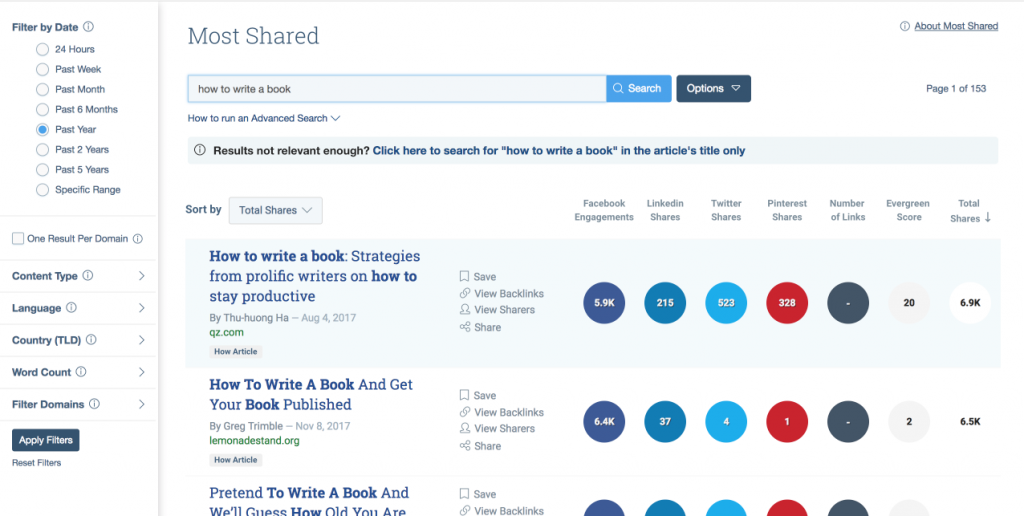
As shown above, I’d then be presented with a list of content relating to this topic of which have been highly shared in the past.
Because this content has been highly shared, it gives me a pretty good sense of what my target audience will be interested if they’re looking for content that teaches them ‘how to write a book.’
The second thing you need to focus on, is making sure your content provides a good ‘user experience’ for the person who is consuming it.
It’s all very well writing long form content, but if that means people are going end up being presented with a wall of text, your target audience isn’t really going to be able to enjoy what you’ve written.
At the very least you need to make sure that you’re using some sort of ‘table of contents’ – especially for long form content.
You’ll should also make sure your content is broken down into small paragraphs (like the text in this blog post) so that people can easily skim through the content.
On top of that ,you need to make sure that you’re using a lot of relevant images in your content, all of which can help make your content seem more engaging.
If you really want to make your content more engaging, think about using some sort of custom design on your website.
UAV coach is a great example of how this can be done.

Their ‘How to Fly a Drone’ guide is a great example of long form, engaging content, that provides a great user experience thanks to custom design and well considered layout.
The third thing you need to pay attention to, is how fast the page loads.
You’ve probably experienced for yourself, the frustration of having to deal with a slow loading page.
And like many others, you might’ve probably just clicked the back button if you find that a page is taking too long to load.
If you want to find out how long it takes for a page to load you can use a service provided by Google, known as ‘PageSpeed Insights.’
This service makes it easy for you to work out how fast a certain webpage is loading and what can be done in order to make it load even quicker.
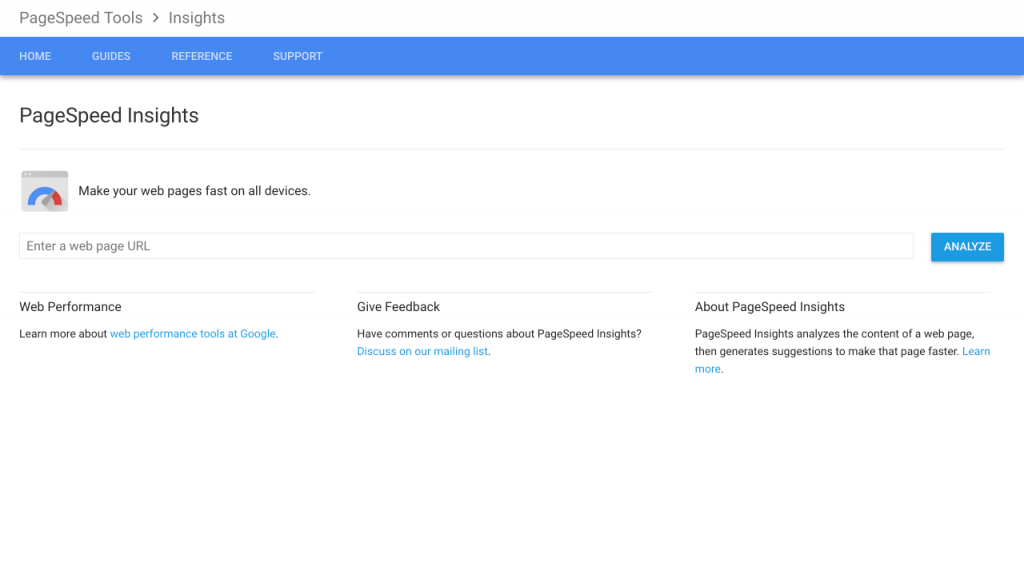
Here’s an example of what you might experience when using the PageSpeed Insights tool.
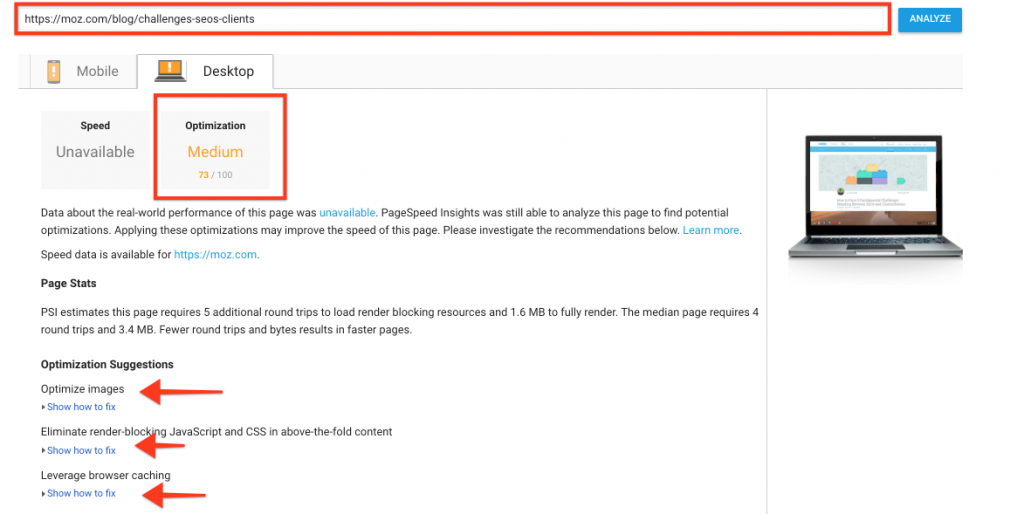
As you can see, the tool provides you with a score out of 100.
The tool will then provide you with some suggestions, telling you what you can do to improve page load times.
For instance, one of the suggestions provided here is that the page could do a better job at ‘optimizing images’ and it could also make use of ‘browser caching.’
This makes sense, since for most people images are the biggest burden on the load speed of a website.
Compressing images can help a great deal when it comes to improving page speed load times.
If you want to compress your images you can use a WordPress plugin to help you get the job done.
‘Smush Image Compression and Optimisation’ is a great example of a plugin that’ll help you compress images and improve the loading time of your images.
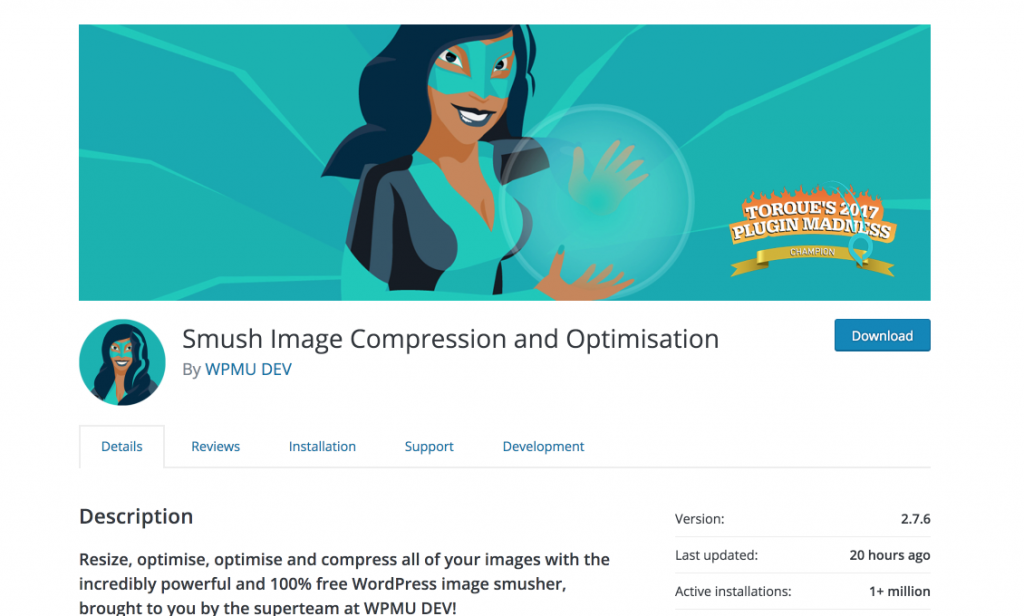
Aside from compressing images, you can also improve the speed at which your webpages load by using something known as a ‘content delivery network’ (also known as a CDN).
Before purchasing a CDN service double check that your hosting provider doesn’t already have a CDN offering.
Nowadays, there are a lot of hosting providers that’ll be able to help provide you with a CDN service, because they’re aware of how important it is to have a fast loading website.
If, however, your website hosting service does not provide a CDN service then you can use a platform known as Cloudflare to help you set up a CDN.

Cloudflare provides a free option, for people who want to test out the service. Depending on your usage, you can get by with the free option for as long as you want.
HTTPS (SSL Certificate Installation)
Another thing that is starting to become a significant ranking factor, is the use of HTTPS.
Google announced all the way back in 2014, that it was going to use HTTPS as a ranking signal.
There is evidence, however, that HTTPS is starting to affect search engine rankings more and more.
HTTPS is a form of encryption that helps to protect the data of the people who are using your website.
Remember – Google is looking to provide its users with the best web experience possible.
If it can send people to a website that is going to protect the data of its users, why not give that website more visibility than a similar website that doesn’t have HTTPS.
If your SEO revolves around markets that aren’t really that competitive, then it is clear to see how HTTPS can give you the edge against your competitors.
And if you are in a competitive market, then it seems like HTTPS is pretty much something you’ll have to invest in if you want to compete against everyone else.
This chart from SemRush, does a great job at showing how the higher ranking domains are the ones that have implemented HTTPS.
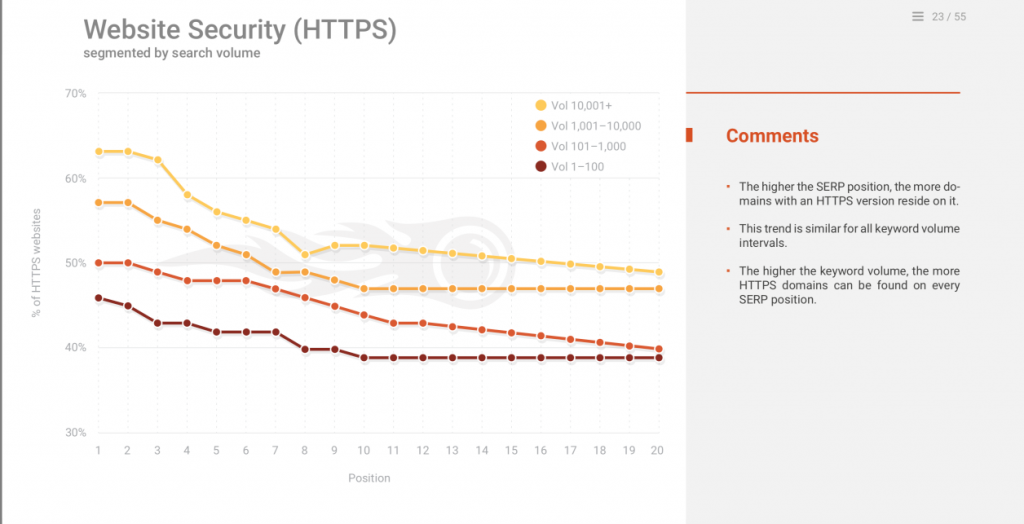
The chart also goes to show that the more search volume a particular keyword has, the more likely it will be that the top domains are making use of HTTPS.
On-Page SEO
On page SEO is as important as ever.
After all, on page SEO let’s you show Google that your content is the most in depth piece of content, for a given topic.
However, you’ll want to be careful when optimising your On Page SEO as you don’t want to do anything that is going to make it look like you’re ‘keyword stuffing’ your pages.
Here are some of the On Page SEO ranking factors you need to pay attention to and things you should keep in mind, when adjusting On Page SEO for your site.
For one, it still helps to have your keyword in the title tag of your page.
The need for this is evidenced by this research performed by Semrush.
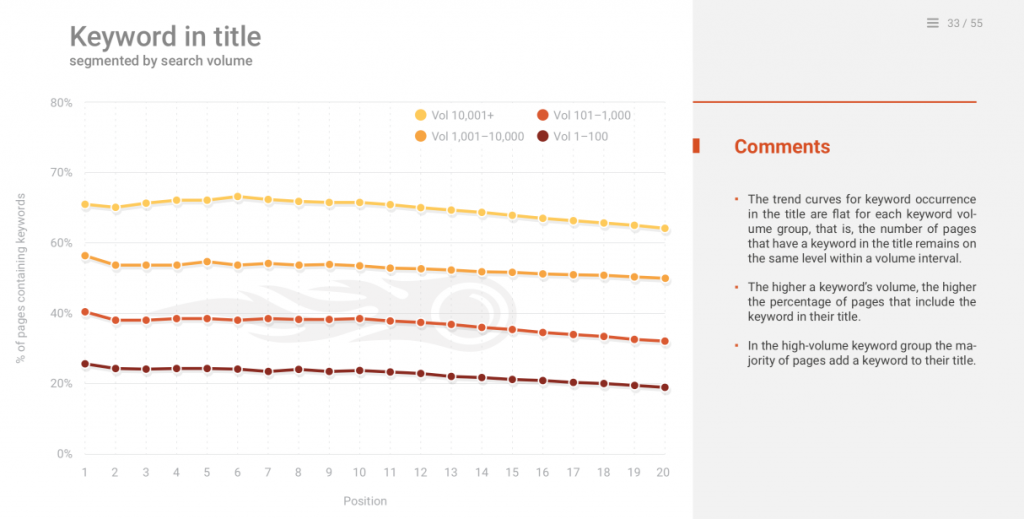
It’s also a good idea to make sure you have the keyword in the meta description of your page. The evidence for doing this, is also shown below.
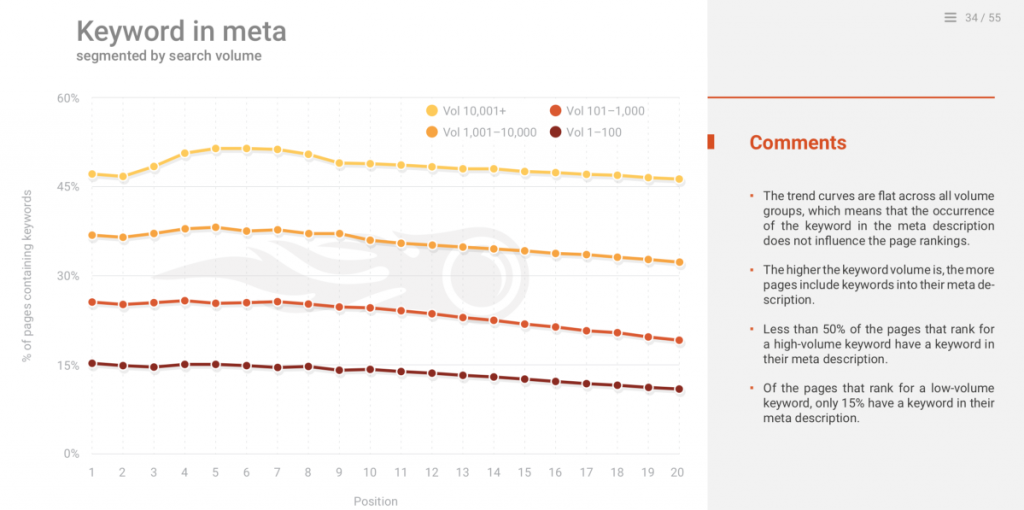
You also want to make sure that you use your chosen keyword within the body of your text.
Again, the chart below, shows that at least 75% of pages that rank highly, have the keyword in the body text.
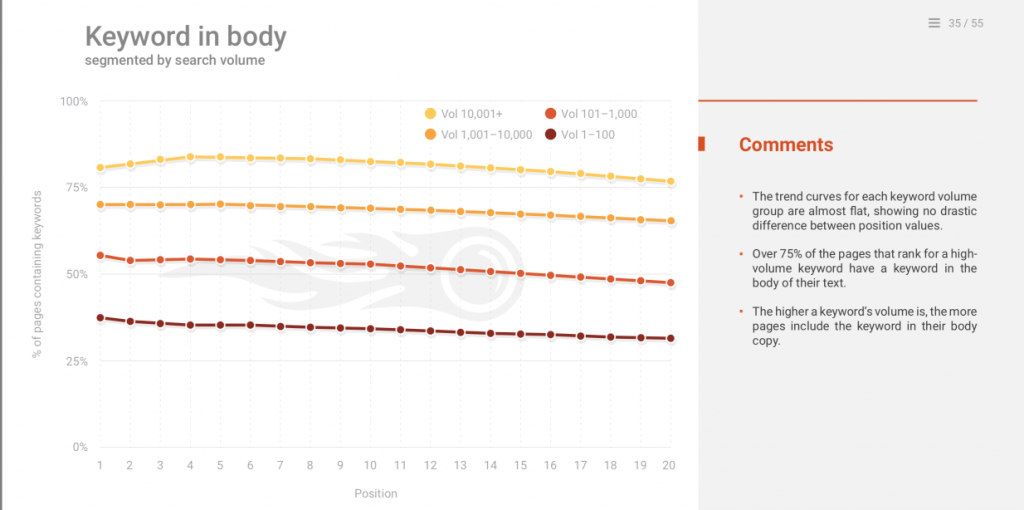
You’ll also want to pay attention to a bunch of other factors too when sorting out your On Page SEO.
For one, you’ll want to make sure you’re using a lot of synonyms and related words, in your text.
This can help you show Google that your content covers a topic in a lot of depth, and hence it is the best out there, for a given topic.
Let’s look at how this can be done.
Imagine I created a piece of content based on the keyword ‘dog training for puppy.’

The first thing I can do is scroll down to the bottom of the search results for this term and review some of the other suggested terms.

These other terms are worth including in my piece of content, because in doing so I will be able to make it so that my content is going to be the ultimate resource on this topic.
Including these other keywords will also help improve the odds that Google will recognise my content as being relevant.
When it comes to related keywords, the term Latent Semantic Indexing Keywords is often used.
Latent Semantic Indexing, just refers to keywords that are related, but not necessarily directly, to your core keyword.
When performing keyword research on your page, you should try to also include some related LSI keywords within the H2 tags of your content.
This will also improve the odds that your content will be able to rank for terms outside of your core, chosen keyword.
You can find additional keywords using Google Keyword Planner.
To do this head over to and then type in your chosen keyword.

The tool will then bring up a list of related keywords.
It can be hard to organise all of these keywords into similar groups, so click on the ‘Ad group ideas’ tab, to help organise everything.

In doing so, you can now find groups of keywords that you should include within your piece of content.
It is important that you figure out how to include relevant, related keywords in your text, because Google is now getting into the habit of serving up one piece of content for multiple keywords.
We created a single piece of content, that in a way, optimizes around a single keyword – Digital Marketing Agency.
However, the page dedicated to this keyword ranks for a lot more than just one keyword.
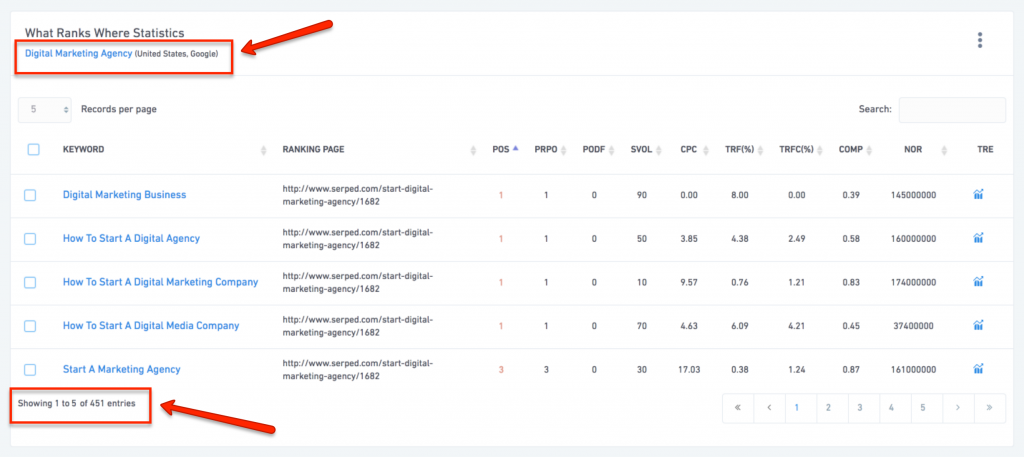
Aside from the obvious backlinks that the post has been able to generate, It also ranks for so many keywords, because we paid a lot of attention to On Page SEO and the use of keywords on the page.
Another way you can find LSI keywords, is by using a tool known as LSIGraph.
Here is an example of what I managed to generate with the tool, when using the keyword from earlier.

As you can see, the tool was able to provide me with a lot of keywords that can be used in a piece of content, that’ll help it seem more relevant in the ‘virtual’ eyes of Google.
Backlinks
As you might’ve guessed, backlinks are still important an important ranking factor in 2018.
But… Just how important are they?
Firstly, let’s look at ‘Total backlinks’ and how this ranking factor can impact ranking ability.
As you can see in the chart above, backlinks still play an important role in influencing ranking potential.
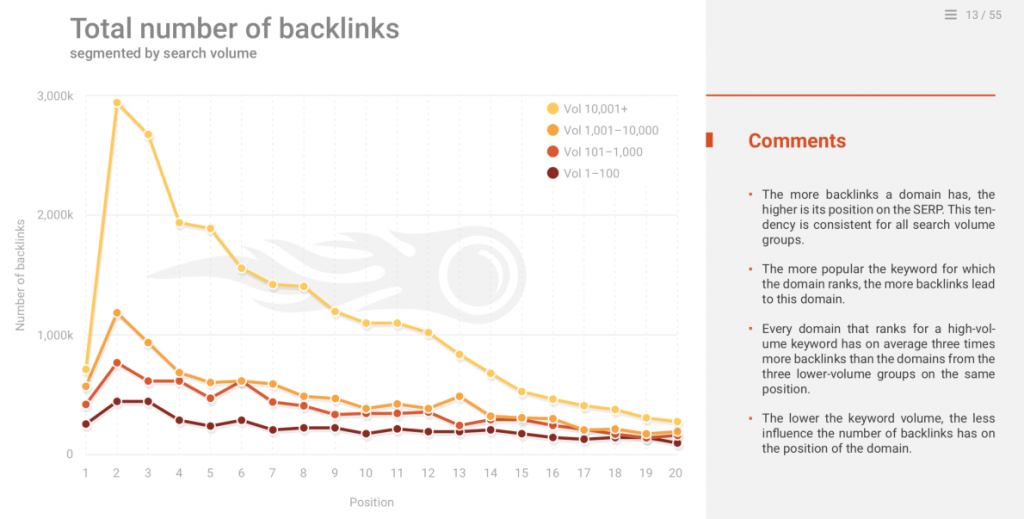
There’s no doubt that backlinks will continue to be of importance for many years to come. The challenge is that you need to figure out how to build backlinks in a way that is sustainable and ‘white-hat.’
Sure you can build backlinks in a questionable manner, but with Google making use of machine learning more and more, it’s going to be difficult to game the system in the coming years.
Plus, if you’re focusing on building a brand that is going to stand the test of time, then it really is a good idea to focus on building your website in the most sustainable manner possible.
Secondly, let’s take a look at referring domains.
Referring domains, relates to the number of different websites that are linking to a given website.
There’s reason to believe that websites that are ranking #1 for a given keyword, don’t have the most referring domains.
However, websites after the #1 spot, generally rank higher, the more referring domains they have pointing to them.
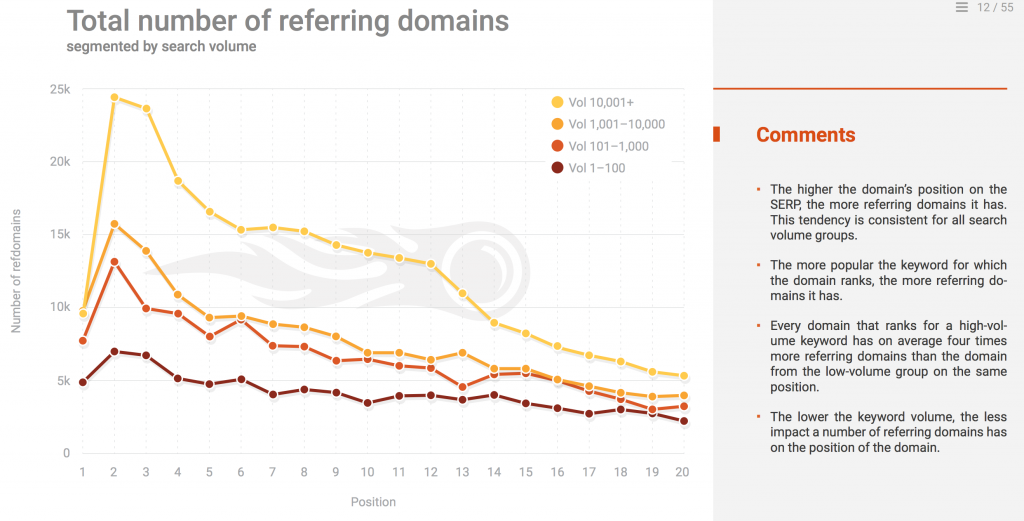
It’s worth mentioning, however, that when it comes to ‘pages’ you’ll tend to find that the higher a page is ranking, the more referring domains it has – all of which is again highlighted in the chart above.
All in all, therefore, you should focus on building backlinks from as many websites as possible.
Next, let’s look at how ‘anchors’ and their impact as a ranking factor.
Anchor text is simply the text that people use when they’re linking out to your site.

Here is a chart, that helps detail how ‘Total number of anchors’ can have an impact on a websites ability to rank.
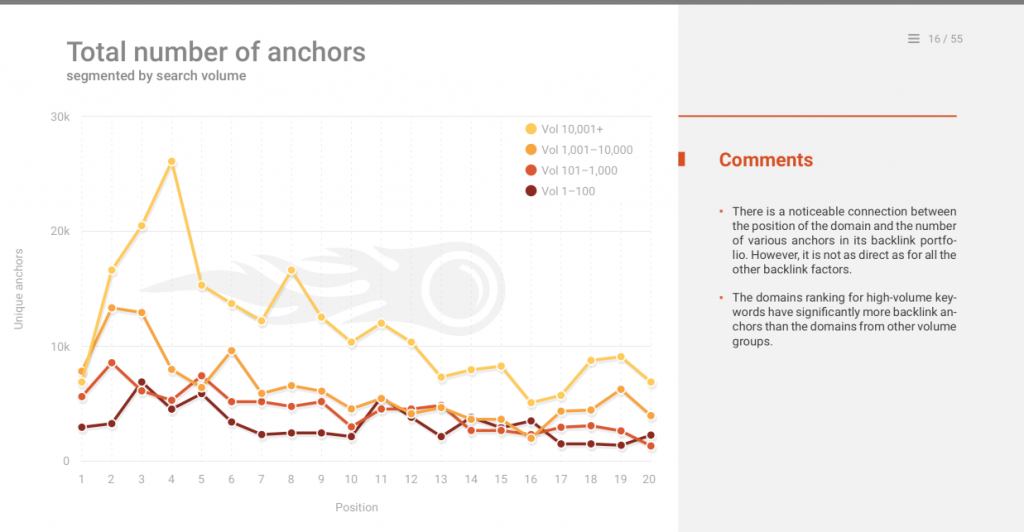
The chart above does a good job at highlighting the fact that a wide range of ‘anchors’ can be helpful when it comes to improving the rankings of a website.
The highest ranking websites, tend to have a diverse range of anchors.
This is likely due to the diverse range of anchors helping to signal to Google, that this site is trustworthy – since it’s not necessarily easy to get a wide range of anchors, that are most likely quite random too.
But what about having the keyword in the anchor?
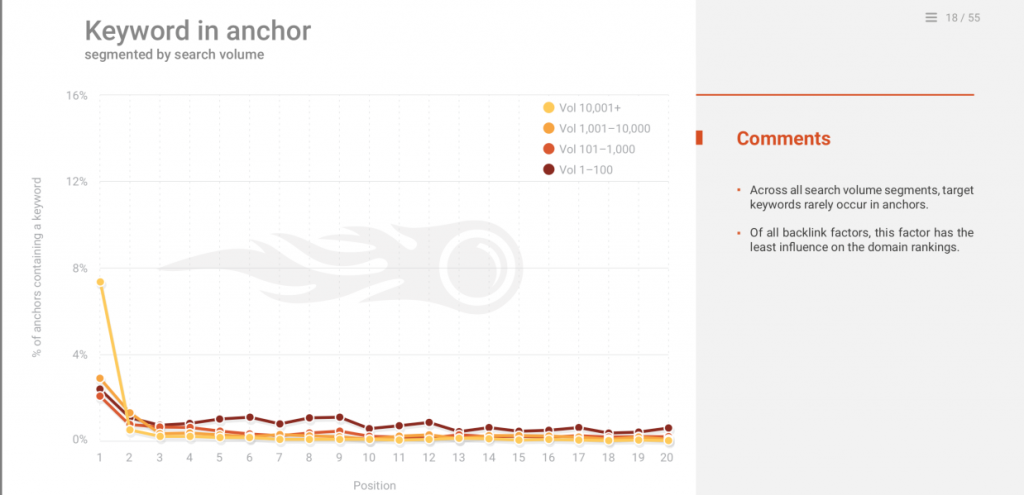
Famously, Google penalised a lot of websites not too long ago, that had a lot of suspiciously similar anchors.
As shown in the chart above, nowadays, if you look at some of the top ranking websites, it seems as though they’re less reliant on having keywords in the anchors.
There’s a lot more you could look into, when it comes to identifying how backlinks could impact rankings in 2018.
However, for the most part it’s clear to see that websites with diverse, ‘natural’ backlink profiles tend to do the best – as shown be the data on the top ranking websites.
If your backlink profile follows any sort of pattern – like the one below, then there’s a chance that you’re going to be exposing yourself to some sort of risk.

After all, with machine learning becoming ever more present in Google's strategy for optimising search results, it won’t be too hard for some sort of machine learning algorithm to catch onto what you’re doing.
Satisfying RankBrain
In this post, we’ve referred a variety of things that generally relate to the concept of RankBrain – which might not have seemed obvious at first.
RankBrain is the machine learning algorithm that Google is using in order to work out which content is best.
For the most part, it is thought that RankBrain relies primarily on user signals, in order to determine the ranking of content.

A couple of years ago, Google announced that RankBrain is the third most important factor when it comes to deciding how the content in its search engines should rank.
With machine learning becoming even more powerful and refined, there’s no reason to think that RankBrain is going to be going anywhere.
RankBrain is special, because it impacts the rankings, ‘on-the-fly.’
So why does all of this matter?
Well, for one, it means that you’re now able to influence the search engine rankings, without always having to rely on backlinks and content – provided you can get people to read and engage with your content.
Now, we’ve already covered how you can improve engagement levels, earlier in this post.
However, what we didn’t talk about, was improving the CTR of your search engine listings.
If you can improve the CTR of your search engine listings – and then keep people engaged once they’re on your page, you’ll be able to satisfy RankBrain.
This means that you’ll therefore be able to improve your search rankings, without building links or adding more content.
And so because of this, you need to develop a better understanding of how to write title tags and meta descriptions that are going to draw people in and make them want to click.
One of the best ways to do this, is by studying the paid results, for a given keyword.
In most cases, these people have spent a lot of time, effort and money to figure out what they can do to make people click on their listing.
You can do this, even for keywords/topics that aren’t related to your specific piece of content.
For instance, here is an example related to the keyword ‘order flowers.’

As you can see, a lot of these top listings make use of specific numbers, to help draw attention.
They’re also touching on key points that might pique the interest of their target market.
Now, you might think that this stuff is irrelevant.
But suppose we’re writing a blog post about ‘how to run faster.’
We could use what we’ve learned above, to help use write a blog post title that is going to draw attention.
How?
By using specific numbers and related interests of your target market – here’s an example:
“How to Improve Running Speed by 10% (in 30 days).”
The specificity used in that title tag, is likely going to help make the search listing seem more enticing.
We can also use the meta description to overcome some of the ‘objections’ someone might have, when it comes to such a topic.
For example, the meta description could be – ”Learn how to run 10% faster in 30 days without injuring yourself or without having to spend money on fancy equipment.”
In doing all of this, you improve the odds that your content will achieve a better than average CTR. If your content is good, this will mean that your content now signals to Google RankBrain that it is achieving high levels of user satisfaction.
And all of this will help improve the odds of your content ranking higher in the search results, for a given term – or maybe even a wide variety of terms.
You may also want to do some ‘conversion rate optimization’ (CRO) testing on your web pages, in order to see what can be done to improve engagement levels.
CRO is where you split test variations of a webpage against one another
When you do this for you web pages, it will become easier to figure out how you can adjust your webpage, in order to improve the level of engagement your pages are able to achieve.
A simple way to conduct CRO testing, is with the help of a tool like VWO.
Conclusion
In this post, we’ve taken a look at some of the ranking factors that you’ll want to pay attention to in 2018.
There’s a lot that we have covered in this blog post and it can feel like you may have a lot to work on.
In any case, for the most part, you’ll find that a lot of what we’ve covered is really just a refinement of what you’re doing already.
Basic SEO principles still apply, but now you just need to make sure you’re accounting for RankBrain and long term SEO approaches that are going to be sustainable.
Your competitors might not even be aware of the changes that are affecting the SEO landscape.
So it is important that you attention to these varying ranking factors and their impact on your website.
And so the sooner you take action – the sooner you’ll be able to gain a competitive advantage in the search results.
Good luck!



